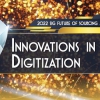At the time of writing this piece, I am just one of five million people emerging from the world’s longest coronavirus-related lockdown, in Melbourne, Australia. For nearly two months, I was only allowed to leave the house once a day for essential items and required to stay within three miles of my home. From takeaway meals to IT support, to doctor’s appointments, most of the goods and services I've needed have been ordered virtually. Since COVID-19 hit, I’m amazed at how quickly the world went virtual.
Along with SAP colleagues and millions of workers globally, I’ve quickly adapted to working from home – connecting with others through virtual collaboration and networking tools. Imagine my surprise, then, when I received a notification in the mail that my driver’s license needed to be updated to reflect my correct birth date, requiring me to physically go to VicRoads, the DMV for the state of Victoria. How is it possible that under the strictest lockdown in the world, with thousands of workers operating remotely, I was still required to be physically present at the DMV to confirm my birth date and identity; especially knowing that the documents required could have easily been scanned and sent?
Before the coronavirus pandemic hit, the journey to digital transformation was underway across many industries. Whether through the purchase of large-scale enterprise resource planning (ERP) offered by companies like SAP, or through individual contracts with suppliers specializing in virtual banking, e-signatures, contracts or hiring, companies have taken steps to manage their businesses digitally. This move has paid off in the current environment.
But not all transformations are created equal, and not all processes benefit, as I learned from my experience. Certain companies and industries are slower to make changes, and even the best transformations leave out many opportunities. Unique challenges, including red tape, limited budgets and competing interests, prevent investment and adoption. How can technology and procurement providers better support the public sector’s move to the 21st century?
A Catalyst for Change
The initial outbreak of coronavirus rocked global supply chains. Hospitals, nursing homes and health care facilities around the world scrambled to obtain personal protective equipment, hospital beds and ventilators. As the pandemic unfolded and cases began spiking, many traditional channels of supply shut down.
To assist our customers at this time, SAP extended the use of SAP Ariba Discovery, for free, through the end of 2020. This enables buyers to post their immediate sourcing needs and for suppliers to respond. One extraordinary customer story involved a supplier who could source 500 hospital beds in less than 30 minutes, delivering much-needed support to a New York City hospital – one of the worst-hit cities at the onset of the pandemic. Unlike our competitors, our size and scale made the difference in helping the hospital in record time.
While many companies stepped forward to assist, the process was ad hoc. Underlying processes in many public and private institutions have not been fundamentally altered to quickly or efficiently address such requests. As a society, we increasingly need to prepare for disruption in the form of cyber-attacks, natural disasters and once-in-a-century pandemics. Low probability, high-impact events cannot be ignored to be dealt with on a one-off basis.
Microsoft CEO Satya Nadella captured the feeling of the moment when presenting Q2 earnings to Wall Street, “We’ve seen two years’ worth of digital transformation in two months. From remote teamwork and learning to sales and customer service, critical cloud infrastructure, and security—we are working alongside customers every day to help them adapt and stay open for business in a world of remote everything.”
COVID-19 has clearly demonstrated the need for digitalization and automation, two key areas that would help drive efficiency and expediency across all business processes.
Marrying Front and Back Office Functions
Some within the procurement function view automation as a potential threat to their livelihood. But the goal of automation isn’t to take away work from humans and give it to machines. The goal is to empower humans to take on more complex and strategic roles within their organizations and elevate the procurement function from back to front office.
By replacing certain functions (data entry, email, text summarization) with automation (predictive analytics, machine learning and document intelligence), companies can hire specialists versus generalists and improve cost-saving alongside productivity. Human resources, finance and procurement functions present the greatest opportunity, with 60% to 80% of tasks deemed automatable and potential cost reduction by at least 30%, according to McKinsey.
Digitalization would also prove a game-changer for the public sector. Even as many front-office services have moved online, siloed databases, paper-heavy processes, and outdated IT lead to longer wait times on returns for applications and forms in the back office.
COVID-19’s impact is felt far and wide, permeating all parts of our lives. Couples trying to get married or divorced are facing similar challenges – endless bureaucracy and delayed court dates. And while inconvenient for some, global shutdowns have been devastating for others. Millions of unemployment claims were met with crashed websites and long lines. Even contact tracing, touted as one of the best ways to monitor and stop the spread of coronavirus, has proved challenging without accurate data on citizens.
And while undoubtedly governments have struggled in this space, there are some powerful success stories, as well. Estonia, India and Taiwan serve as sources of inspiration.
Investing in a Digital Future
It’s hard to believe Estonia’s electronic identity (eID) system has been around for more than 15 years. Bridging the gap between the public and private sector, the eID is used by Estonia’s citizens every day for activities ranging from accessing public transit and medical care, to filing their taxes, signing documents and voting online. No need for two-factor authentication or to physically go to a government building. In the age of COVID-19, Estonia can serve its citizens quickly and efficiently, saving time and money.
Similarly, since 2009, India’s national biometric digital identity program Aadhaar has enrolled 1.2 billion people, making it the world's single most extensive digital ID program. Like Estonia, the adoption of Aadhaar encouraged the growth of other digital services. An article by McKinsey reveals, “870 million bank accounts were linked to Aadhaar by February 2018, compared with 399 million in April 2017 and 56 million in January 2014. Likewise, the Goods and Services Tax Network, established in 2013, brings all transactions of about 10.3 million indirect tax-paying businesses onto one digital platform, creating a powerful incentive for companies to digitize their operations.”
Taiwan is also taking a novel approach to supporting citizens by providing an economic stimulus via its health insurance system. The move assists brick and mortar businesses.
Naturally, convincing countries around the world to adopt this type of technology is often met with resistance. Protecting personal data and records presents concerns. Fraud, in the form of voting or insurance, for example, comes to mind. But if countries took the first steps to build the ecosystem necessary to support such measures, we would all benefit. Tony Blair, former prime minister of the United Kingdom, has called for Britain to invest in a citizenship register like Estonia’s.
The pandemic has only heightened the need for digital services across the world. To deliver the experience that citizens truly deserve, all organizations, across all industries, should create a list of all processes that require manual work and physical presence and try to eliminate them. Evaluate each microscopically and assess if they can be digitized.
In one of my discussions with the Chief Procurement Officer of BHP, Sundeep Singh, he mentioned that procurement organizations are uniquely positioned to drive their companies' innovation agenda because no other function can “serve as the window to the outside world.” My invitation is to take this innovation beyond the private sector to help all the world’s citizens, particularly those destined to spend an afternoon at the DMV.







